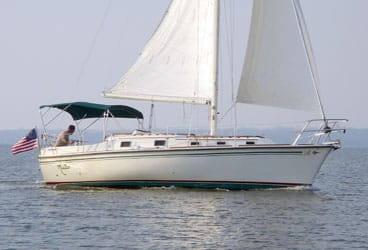
Allmand 31
Allmand Boats of Hialeah, Florida, was originally a powerboat manufacturer, but during the energy crunch of the 1970s, it turned its attention entirely to sailboats. Walter Scott and T. R. Allmand collaborated on the designs, and in 1979 the company introduced three sailboat models. The Allmand 31 was, and continues to be, the most popular design. It remained in production until 1985, when the industry-wide recession of the 1980s forced Allmand to close its doors for good.
Overall, the design of the Allmand 31 is quite conservative yet contemporary. From the steep, slightly concave bow to the near-vertical stern, the sheer is almost flat. The long, low cabin trunk has a slight step-up aft. Beneath the waterline, the boat has a long, shallow keel, and the rudder is mounted on a partial skeg.
While the hull is solid fiberglass, the deck is cored with end-grain balsa. The deck mates to the hull on an outward-facing flange. This joint is bonded with resin, fastened with self-tapping screws, glassed over on the inside, and covered with a vinyl rubrail. Ballast is internal and is either cast iron (as part of the standard rig) or lead (for the tall rig).
Most of the Allmand 31s were built with a tri-cabin layout. One cabin, with the V-berth, is forward. The head compartment and a pair of hanging lockers are aft of that. The second cabin is the main saloon, in which a U-shaped dinette faces a straight settee berth and a U-shaped galley to starboard. The third cabin is aft to port. It contains a double berth, a hanging locker, and a fold-down chart table.
Under sail, the boat accelerates quickly, but windward performance is hampered by its wide beam and shoal draft. Although the 31 will tack through about 90 degrees and is extraordinarily stiff and sails almost level, it makes noticeable leeway. Its best points of sail are off the wind.
The most common auxiliary is the 16-horsepower M20 Universal diesel. The 21-horsepower M25 was available as an option, and either one is adequate in most conditions.
As well as checking for age-related problems typical of older boats, a prospective buyer should examine the keel cavity for signs of a hard grounding, especially on boats with cast-iron ballast. If a break in the outer skin has let in water, the cast iron can suffer significant and costly corrosion.
The strongest features of the Allmand 31 are its generous interior and its spacious cockpit. Its moderate rig is easily managed, but the shoal draft and the smallish sail area make the Allmand 31 a better candidate for coastal cruising than bluewater sailing. The boat is solidly constructed and doesn’t look that dated, but the builder wasn’t known for sailboats, and this probably accounts for the 31’s current depressed price: $14,000 to $30,000 will get you a very roomy 31-footer.
Gregg Nestor, the author of three books about sailboats, has maintained a lifelong interest in all things aquatic.








